Hypothetical Design and In Vitro Testing of a Biodegradable Scaffold for Cartilage and Osteochondral Defects
VerifiedAdded on 2023/01/11
|9
|2847
|50
AI Summary
This article discusses the hypothetical design and in vitro testing of a directly implantable biodegradable scaffold for cartilage and osteochondral defects. It covers the clinical need, scaffold development, surface treatment regimes, and preliminary in vitro tests. The scaffold is based on bioceramics synthesized from a solid state reaction method and is aimed at enhancing cartilage regeneration and osteochondral repair.
Contribute Materials
Your contribution can guide someone’s learning journey. Share your
documents today.
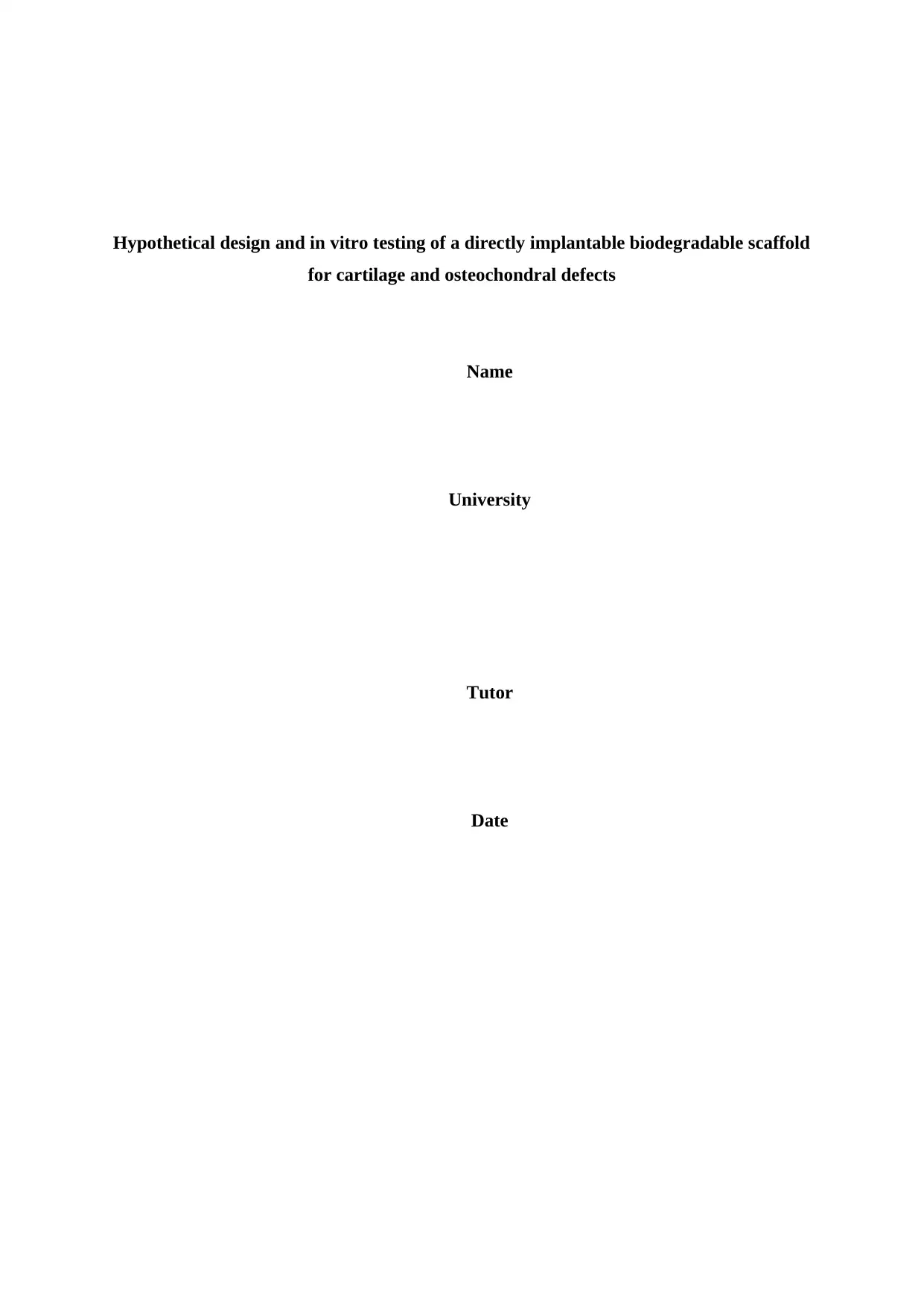
Hypothetical design and in vitro testing of a directly implantable biodegradable scaffold
for cartilage and osteochondral defects
Name
University
Tutor
Date
for cartilage and osteochondral defects
Name
University
Tutor
Date
Secure Best Marks with AI Grader
Need help grading? Try our AI Grader for instant feedback on your assignments.
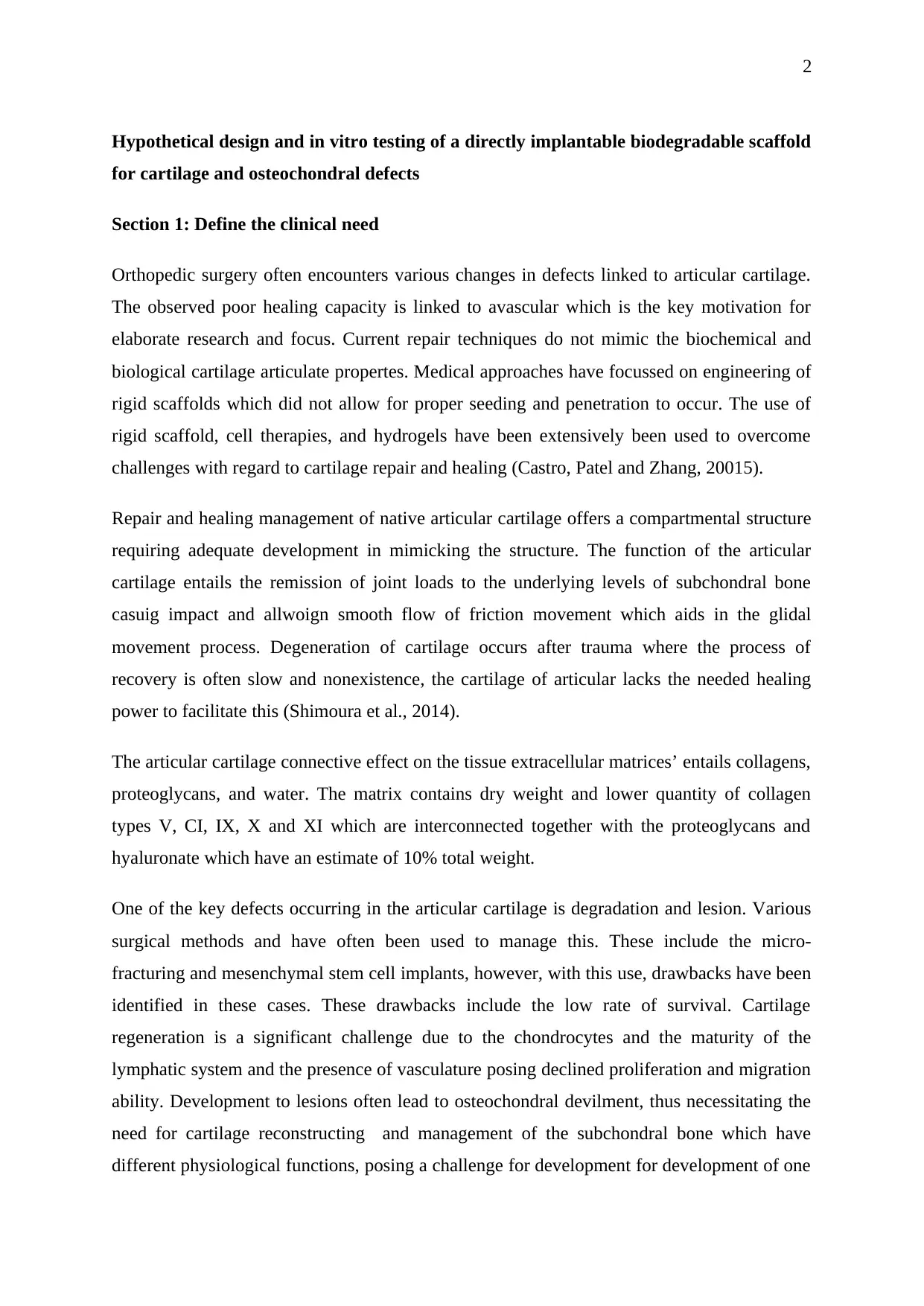
2
Hypothetical design and in vitro testing of a directly implantable biodegradable scaffold
for cartilage and osteochondral defects
Section 1: Define the clinical need
Orthopedic surgery often encounters various changes in defects linked to articular cartilage.
The observed poor healing capacity is linked to avascular which is the key motivation for
elaborate research and focus. Current repair techniques do not mimic the biochemical and
biological cartilage articulate propertes. Medical approaches have focussed on engineering of
rigid scaffolds which did not allow for proper seeding and penetration to occur. The use of
rigid scaffold, cell therapies, and hydrogels have been extensively been used to overcome
challenges with regard to cartilage repair and healing (Castro, Patel and Zhang, 20015).
Repair and healing management of native articular cartilage offers a compartmental structure
requiring adequate development in mimicking the structure. The function of the articular
cartilage entails the remission of joint loads to the underlying levels of subchondral bone
casuig impact and allwoign smooth flow of friction movement which aids in the glidal
movement process. Degeneration of cartilage occurs after trauma where the process of
recovery is often slow and nonexistence, the cartilage of articular lacks the needed healing
power to facilitate this (Shimoura et al., 2014).
The articular cartilage connective effect on the tissue extracellular matrices’ entails collagens,
proteoglycans, and water. The matrix contains dry weight and lower quantity of collagen
types V, CI, IX, X and XI which are interconnected together with the proteoglycans and
hyaluronate which have an estimate of 10% total weight.
One of the key defects occurring in the articular cartilage is degradation and lesion. Various
surgical methods and have often been used to manage this. These include the micro-
fracturing and mesenchymal stem cell implants, however, with this use, drawbacks have been
identified in these cases. These drawbacks include the low rate of survival. Cartilage
regeneration is a significant challenge due to the chondrocytes and the maturity of the
lymphatic system and the presence of vasculature posing declined proliferation and migration
ability. Development to lesions often lead to osteochondral devilment, thus necessitating the
need for cartilage reconstructing and management of the subchondral bone which have
different physiological functions, posing a challenge for development for development of one
Hypothetical design and in vitro testing of a directly implantable biodegradable scaffold
for cartilage and osteochondral defects
Section 1: Define the clinical need
Orthopedic surgery often encounters various changes in defects linked to articular cartilage.
The observed poor healing capacity is linked to avascular which is the key motivation for
elaborate research and focus. Current repair techniques do not mimic the biochemical and
biological cartilage articulate propertes. Medical approaches have focussed on engineering of
rigid scaffolds which did not allow for proper seeding and penetration to occur. The use of
rigid scaffold, cell therapies, and hydrogels have been extensively been used to overcome
challenges with regard to cartilage repair and healing (Castro, Patel and Zhang, 20015).
Repair and healing management of native articular cartilage offers a compartmental structure
requiring adequate development in mimicking the structure. The function of the articular
cartilage entails the remission of joint loads to the underlying levels of subchondral bone
casuig impact and allwoign smooth flow of friction movement which aids in the glidal
movement process. Degeneration of cartilage occurs after trauma where the process of
recovery is often slow and nonexistence, the cartilage of articular lacks the needed healing
power to facilitate this (Shimoura et al., 2014).
The articular cartilage connective effect on the tissue extracellular matrices’ entails collagens,
proteoglycans, and water. The matrix contains dry weight and lower quantity of collagen
types V, CI, IX, X and XI which are interconnected together with the proteoglycans and
hyaluronate which have an estimate of 10% total weight.
One of the key defects occurring in the articular cartilage is degradation and lesion. Various
surgical methods and have often been used to manage this. These include the micro-
fracturing and mesenchymal stem cell implants, however, with this use, drawbacks have been
identified in these cases. These drawbacks include the low rate of survival. Cartilage
regeneration is a significant challenge due to the chondrocytes and the maturity of the
lymphatic system and the presence of vasculature posing declined proliferation and migration
ability. Development to lesions often lead to osteochondral devilment, thus necessitating the
need for cartilage reconstructing and management of the subchondral bone which have
different physiological functions, posing a challenge for development for development of one
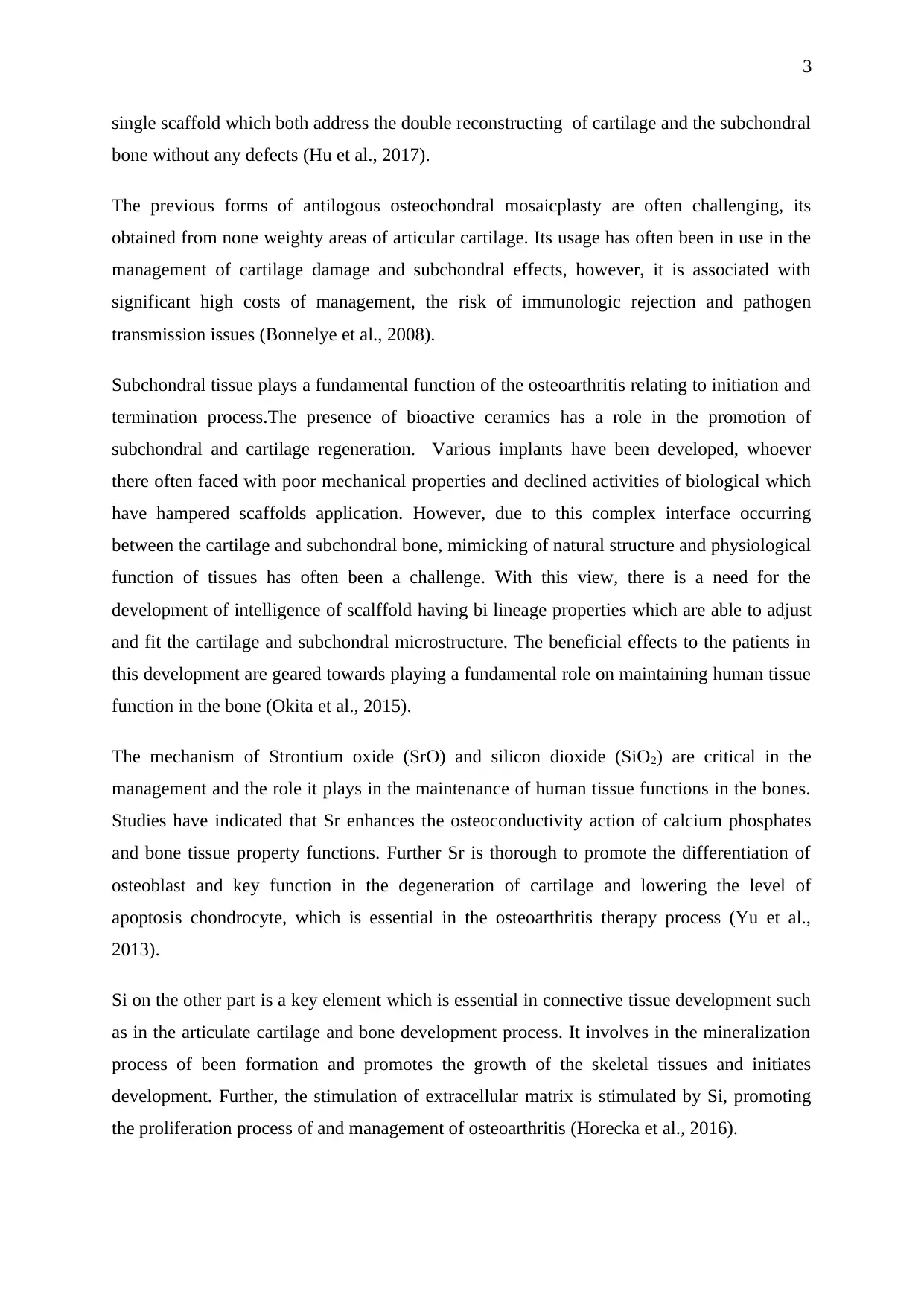
3
single scaffold which both address the double reconstructing of cartilage and the subchondral
bone without any defects (Hu et al., 2017).
The previous forms of antilogous osteochondral mosaicplasty are often challenging, its
obtained from none weighty areas of articular cartilage. Its usage has often been in use in the
management of cartilage damage and subchondral effects, however, it is associated with
significant high costs of management, the risk of immunologic rejection and pathogen
transmission issues (Bonnelye et al., 2008).
Subchondral tissue plays a fundamental function of the osteoarthritis relating to initiation and
termination process.The presence of bioactive ceramics has a role in the promotion of
subchondral and cartilage regeneration. Various implants have been developed, whoever
there often faced with poor mechanical properties and declined activities of biological which
have hampered scaffolds application. However, due to this complex interface occurring
between the cartilage and subchondral bone, mimicking of natural structure and physiological
function of tissues has often been a challenge. With this view, there is a need for the
development of intelligence of scalffold having bi lineage properties which are able to adjust
and fit the cartilage and subchondral microstructure. The beneficial effects to the patients in
this development are geared towards playing a fundamental role on maintaining human tissue
function in the bone (Okita et al., 2015).
The mechanism of Strontium oxide (SrO) and silicon dioxide (SiO2) are critical in the
management and the role it plays in the maintenance of human tissue functions in the bones.
Studies have indicated that Sr enhances the osteoconductivity action of calcium phosphates
and bone tissue property functions. Further Sr is thorough to promote the differentiation of
osteoblast and key function in the degeneration of cartilage and lowering the level of
apoptosis chondrocyte, which is essential in the osteoarthritis therapy process (Yu et al.,
2013).
Si on the other part is a key element which is essential in connective tissue development such
as in the articulate cartilage and bone development process. It involves in the mineralization
process of been formation and promotes the growth of the skeletal tissues and initiates
development. Further, the stimulation of extracellular matrix is stimulated by Si, promoting
the proliferation process of and management of osteoarthritis (Horecka et al., 2016).
single scaffold which both address the double reconstructing of cartilage and the subchondral
bone without any defects (Hu et al., 2017).
The previous forms of antilogous osteochondral mosaicplasty are often challenging, its
obtained from none weighty areas of articular cartilage. Its usage has often been in use in the
management of cartilage damage and subchondral effects, however, it is associated with
significant high costs of management, the risk of immunologic rejection and pathogen
transmission issues (Bonnelye et al., 2008).
Subchondral tissue plays a fundamental function of the osteoarthritis relating to initiation and
termination process.The presence of bioactive ceramics has a role in the promotion of
subchondral and cartilage regeneration. Various implants have been developed, whoever
there often faced with poor mechanical properties and declined activities of biological which
have hampered scaffolds application. However, due to this complex interface occurring
between the cartilage and subchondral bone, mimicking of natural structure and physiological
function of tissues has often been a challenge. With this view, there is a need for the
development of intelligence of scalffold having bi lineage properties which are able to adjust
and fit the cartilage and subchondral microstructure. The beneficial effects to the patients in
this development are geared towards playing a fundamental role on maintaining human tissue
function in the bone (Okita et al., 2015).
The mechanism of Strontium oxide (SrO) and silicon dioxide (SiO2) are critical in the
management and the role it plays in the maintenance of human tissue functions in the bones.
Studies have indicated that Sr enhances the osteoconductivity action of calcium phosphates
and bone tissue property functions. Further Sr is thorough to promote the differentiation of
osteoblast and key function in the degeneration of cartilage and lowering the level of
apoptosis chondrocyte, which is essential in the osteoarthritis therapy process (Yu et al.,
2013).
Si on the other part is a key element which is essential in connective tissue development such
as in the articulate cartilage and bone development process. It involves in the mineralization
process of been formation and promotes the growth of the skeletal tissues and initiates
development. Further, the stimulation of extracellular matrix is stimulated by Si, promoting
the proliferation process of and management of osteoarthritis (Horecka et al., 2016).
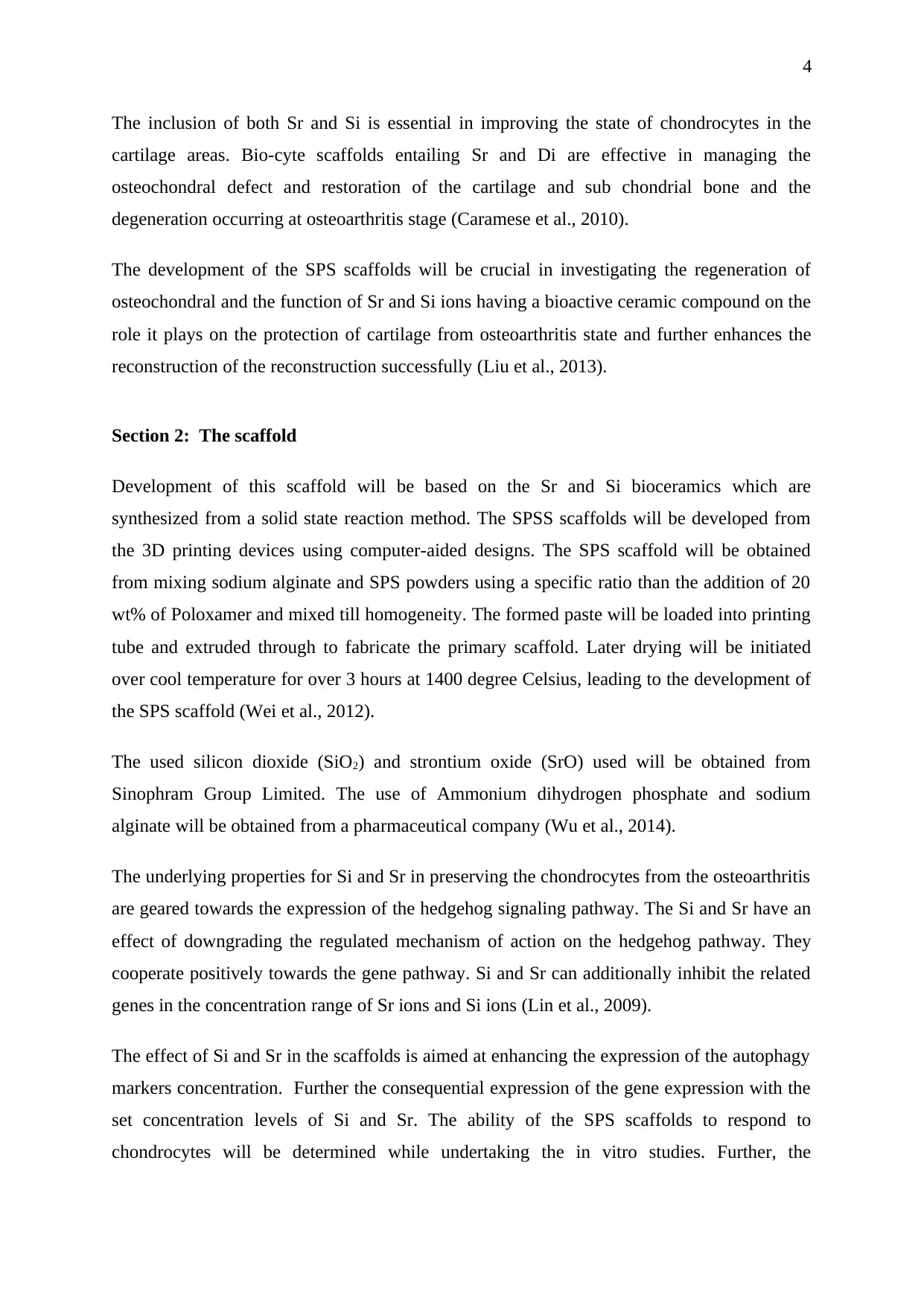
4
The inclusion of both Sr and Si is essential in improving the state of chondrocytes in the
cartilage areas. Bio-cyte scaffolds entailing Sr and Di are effective in managing the
osteochondral defect and restoration of the cartilage and sub chondrial bone and the
degeneration occurring at osteoarthritis stage (Caramese et al., 2010).
The development of the SPS scaffolds will be crucial in investigating the regeneration of
osteochondral and the function of Sr and Si ions having a bioactive ceramic compound on the
role it plays on the protection of cartilage from osteoarthritis state and further enhances the
reconstruction of the reconstruction successfully (Liu et al., 2013).
Section 2: The scaffold
Development of this scaffold will be based on the Sr and Si bioceramics which are
synthesized from a solid state reaction method. The SPSS scaffolds will be developed from
the 3D printing devices using computer-aided designs. The SPS scaffold will be obtained
from mixing sodium alginate and SPS powders using a specific ratio than the addition of 20
wt% of Poloxamer and mixed till homogeneity. The formed paste will be loaded into printing
tube and extruded through to fabricate the primary scaffold. Later drying will be initiated
over cool temperature for over 3 hours at 1400 degree Celsius, leading to the development of
the SPS scaffold (Wei et al., 2012).
The used silicon dioxide (SiO2) and strontium oxide (SrO) used will be obtained from
Sinophram Group Limited. The use of Ammonium dihydrogen phosphate and sodium
alginate will be obtained from a pharmaceutical company (Wu et al., 2014).
The underlying properties for Si and Sr in preserving the chondrocytes from the osteoarthritis
are geared towards the expression of the hedgehog signaling pathway. The Si and Sr have an
effect of downgrading the regulated mechanism of action on the hedgehog pathway. They
cooperate positively towards the gene pathway. Si and Sr can additionally inhibit the related
genes in the concentration range of Sr ions and Si ions (Lin et al., 2009).
The effect of Si and Sr in the scaffolds is aimed at enhancing the expression of the autophagy
markers concentration. Further the consequential expression of the gene expression with the
set concentration levels of Si and Sr. The ability of the SPS scaffolds to respond to
chondrocytes will be determined while undertaking the in vitro studies. Further, the
The inclusion of both Sr and Si is essential in improving the state of chondrocytes in the
cartilage areas. Bio-cyte scaffolds entailing Sr and Di are effective in managing the
osteochondral defect and restoration of the cartilage and sub chondrial bone and the
degeneration occurring at osteoarthritis stage (Caramese et al., 2010).
The development of the SPS scaffolds will be crucial in investigating the regeneration of
osteochondral and the function of Sr and Si ions having a bioactive ceramic compound on the
role it plays on the protection of cartilage from osteoarthritis state and further enhances the
reconstruction of the reconstruction successfully (Liu et al., 2013).
Section 2: The scaffold
Development of this scaffold will be based on the Sr and Si bioceramics which are
synthesized from a solid state reaction method. The SPSS scaffolds will be developed from
the 3D printing devices using computer-aided designs. The SPS scaffold will be obtained
from mixing sodium alginate and SPS powders using a specific ratio than the addition of 20
wt% of Poloxamer and mixed till homogeneity. The formed paste will be loaded into printing
tube and extruded through to fabricate the primary scaffold. Later drying will be initiated
over cool temperature for over 3 hours at 1400 degree Celsius, leading to the development of
the SPS scaffold (Wei et al., 2012).
The used silicon dioxide (SiO2) and strontium oxide (SrO) used will be obtained from
Sinophram Group Limited. The use of Ammonium dihydrogen phosphate and sodium
alginate will be obtained from a pharmaceutical company (Wu et al., 2014).
The underlying properties for Si and Sr in preserving the chondrocytes from the osteoarthritis
are geared towards the expression of the hedgehog signaling pathway. The Si and Sr have an
effect of downgrading the regulated mechanism of action on the hedgehog pathway. They
cooperate positively towards the gene pathway. Si and Sr can additionally inhibit the related
genes in the concentration range of Sr ions and Si ions (Lin et al., 2009).
The effect of Si and Sr in the scaffolds is aimed at enhancing the expression of the autophagy
markers concentration. Further the consequential expression of the gene expression with the
set concentration levels of Si and Sr. The ability of the SPS scaffolds to respond to
chondrocytes will be determined while undertaking the in vitro studies. Further, the
Secure Best Marks with AI Grader
Need help grading? Try our AI Grader for instant feedback on your assignments.
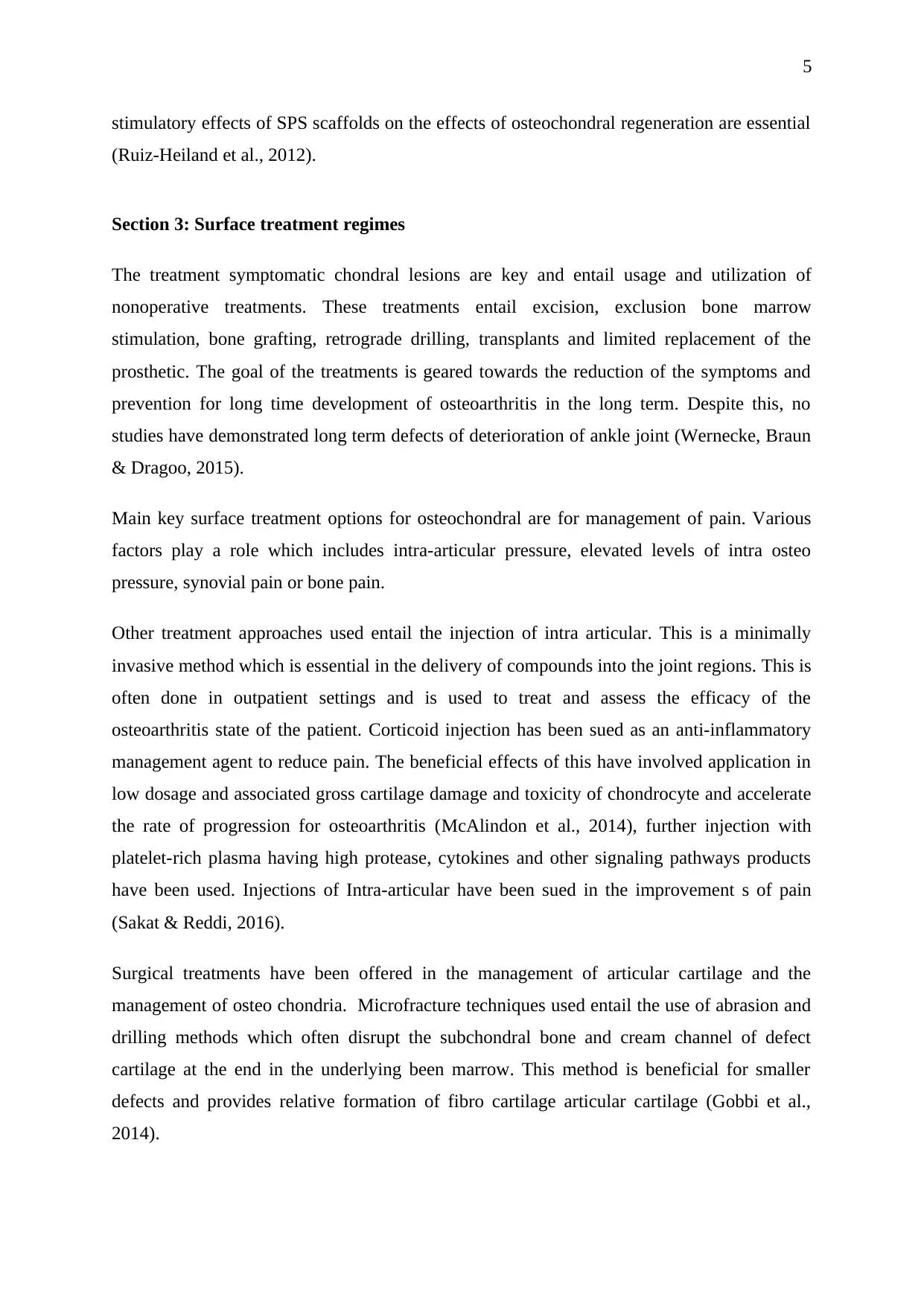
5
stimulatory effects of SPS scaffolds on the effects of osteochondral regeneration are essential
(Ruiz-Heiland et al., 2012).
Section 3: Surface treatment regimes
The treatment symptomatic chondral lesions are key and entail usage and utilization of
nonoperative treatments. These treatments entail excision, exclusion bone marrow
stimulation, bone grafting, retrograde drilling, transplants and limited replacement of the
prosthetic. The goal of the treatments is geared towards the reduction of the symptoms and
prevention for long time development of osteoarthritis in the long term. Despite this, no
studies have demonstrated long term defects of deterioration of ankle joint (Wernecke, Braun
& Dragoo, 2015).
Main key surface treatment options for osteochondral are for management of pain. Various
factors play a role which includes intra-articular pressure, elevated levels of intra osteo
pressure, synovial pain or bone pain.
Other treatment approaches used entail the injection of intra articular. This is a minimally
invasive method which is essential in the delivery of compounds into the joint regions. This is
often done in outpatient settings and is used to treat and assess the efficacy of the
osteoarthritis state of the patient. Corticoid injection has been sued as an anti-inflammatory
management agent to reduce pain. The beneficial effects of this have involved application in
low dosage and associated gross cartilage damage and toxicity of chondrocyte and accelerate
the rate of progression for osteoarthritis (McAlindon et al., 2014), further injection with
platelet-rich plasma having high protease, cytokines and other signaling pathways products
have been used. Injections of Intra-articular have been sued in the improvement s of pain
(Sakat & Reddi, 2016).
Surgical treatments have been offered in the management of articular cartilage and the
management of osteo chondria. Microfracture techniques used entail the use of abrasion and
drilling methods which often disrupt the subchondral bone and cream channel of defect
cartilage at the end in the underlying been marrow. This method is beneficial for smaller
defects and provides relative formation of fibro cartilage articular cartilage (Gobbi et al.,
2014).
stimulatory effects of SPS scaffolds on the effects of osteochondral regeneration are essential
(Ruiz-Heiland et al., 2012).
Section 3: Surface treatment regimes
The treatment symptomatic chondral lesions are key and entail usage and utilization of
nonoperative treatments. These treatments entail excision, exclusion bone marrow
stimulation, bone grafting, retrograde drilling, transplants and limited replacement of the
prosthetic. The goal of the treatments is geared towards the reduction of the symptoms and
prevention for long time development of osteoarthritis in the long term. Despite this, no
studies have demonstrated long term defects of deterioration of ankle joint (Wernecke, Braun
& Dragoo, 2015).
Main key surface treatment options for osteochondral are for management of pain. Various
factors play a role which includes intra-articular pressure, elevated levels of intra osteo
pressure, synovial pain or bone pain.
Other treatment approaches used entail the injection of intra articular. This is a minimally
invasive method which is essential in the delivery of compounds into the joint regions. This is
often done in outpatient settings and is used to treat and assess the efficacy of the
osteoarthritis state of the patient. Corticoid injection has been sued as an anti-inflammatory
management agent to reduce pain. The beneficial effects of this have involved application in
low dosage and associated gross cartilage damage and toxicity of chondrocyte and accelerate
the rate of progression for osteoarthritis (McAlindon et al., 2014), further injection with
platelet-rich plasma having high protease, cytokines and other signaling pathways products
have been used. Injections of Intra-articular have been sued in the improvement s of pain
(Sakat & Reddi, 2016).
Surgical treatments have been offered in the management of articular cartilage and the
management of osteo chondria. Microfracture techniques used entail the use of abrasion and
drilling methods which often disrupt the subchondral bone and cream channel of defect
cartilage at the end in the underlying been marrow. This method is beneficial for smaller
defects and provides relative formation of fibro cartilage articular cartilage (Gobbi et al.,
2014).
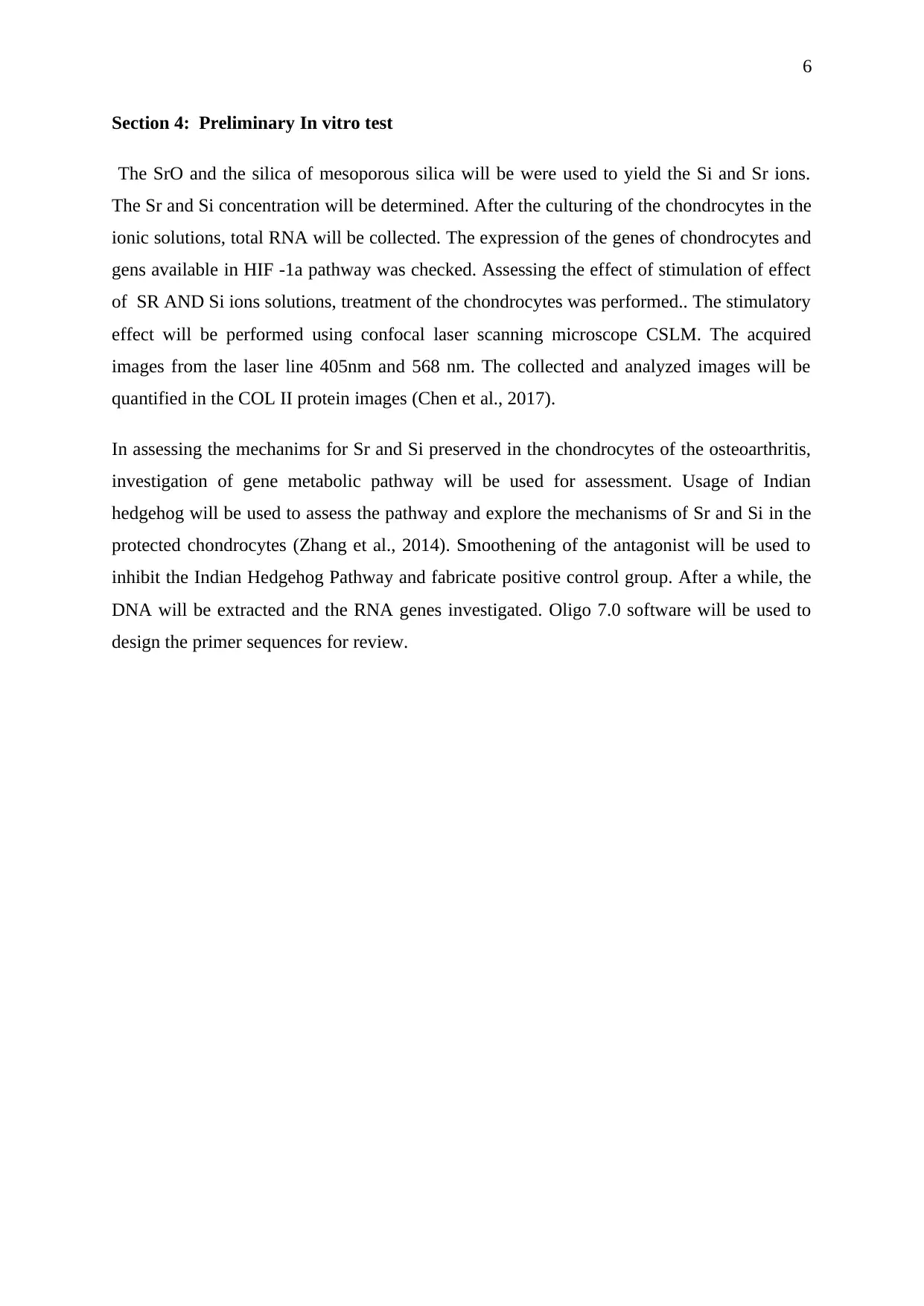
6
Section 4: Preliminary In vitro test
The SrO and the silica of mesoporous silica will be were used to yield the Si and Sr ions.
The Sr and Si concentration will be determined. After the culturing of the chondrocytes in the
ionic solutions, total RNA will be collected. The expression of the genes of chondrocytes and
gens available in HIF -1a pathway was checked. Assessing the effect of stimulation of effect
of SR AND Si ions solutions, treatment of the chondrocytes was performed.. The stimulatory
effect will be performed using confocal laser scanning microscope CSLM. The acquired
images from the laser line 405nm and 568 nm. The collected and analyzed images will be
quantified in the COL II protein images (Chen et al., 2017).
In assessing the mechanims for Sr and Si preserved in the chondrocytes of the osteoarthritis,
investigation of gene metabolic pathway will be used for assessment. Usage of Indian
hedgehog will be used to assess the pathway and explore the mechanisms of Sr and Si in the
protected chondrocytes (Zhang et al., 2014). Smoothening of the antagonist will be used to
inhibit the Indian Hedgehog Pathway and fabricate positive control group. After a while, the
DNA will be extracted and the RNA genes investigated. Oligo 7.0 software will be used to
design the primer sequences for review.
Section 4: Preliminary In vitro test
The SrO and the silica of mesoporous silica will be were used to yield the Si and Sr ions.
The Sr and Si concentration will be determined. After the culturing of the chondrocytes in the
ionic solutions, total RNA will be collected. The expression of the genes of chondrocytes and
gens available in HIF -1a pathway was checked. Assessing the effect of stimulation of effect
of SR AND Si ions solutions, treatment of the chondrocytes was performed.. The stimulatory
effect will be performed using confocal laser scanning microscope CSLM. The acquired
images from the laser line 405nm and 568 nm. The collected and analyzed images will be
quantified in the COL II protein images (Chen et al., 2017).
In assessing the mechanims for Sr and Si preserved in the chondrocytes of the osteoarthritis,
investigation of gene metabolic pathway will be used for assessment. Usage of Indian
hedgehog will be used to assess the pathway and explore the mechanisms of Sr and Si in the
protected chondrocytes (Zhang et al., 2014). Smoothening of the antagonist will be used to
inhibit the Indian Hedgehog Pathway and fabricate positive control group. After a while, the
DNA will be extracted and the RNA genes investigated. Oligo 7.0 software will be used to
design the primer sequences for review.
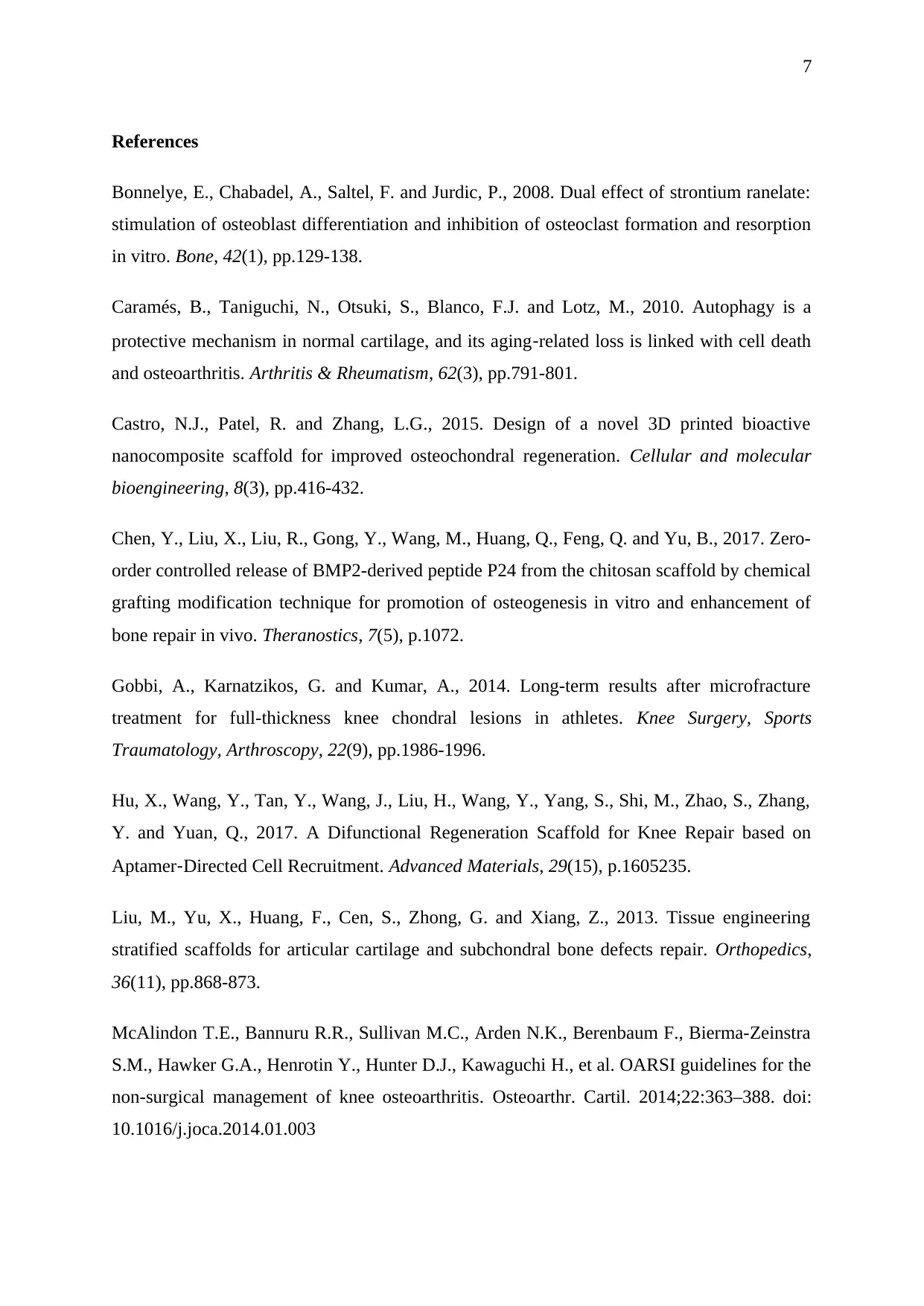
7
References
Bonnelye, E., Chabadel, A., Saltel, F. and Jurdic, P., 2008. Dual effect of strontium ranelate:
stimulation of osteoblast differentiation and inhibition of osteoclast formation and resorption
in vitro. Bone, 42(1), pp.129-138.
Caramés, B., Taniguchi, N., Otsuki, S., Blanco, F.J. and Lotz, M., 2010. Autophagy is a
protective mechanism in normal cartilage, and its aging‐related loss is linked with cell death
and osteoarthritis. Arthritis & Rheumatism, 62(3), pp.791-801.
Castro, N.J., Patel, R. and Zhang, L.G., 2015. Design of a novel 3D printed bioactive
nanocomposite scaffold for improved osteochondral regeneration. Cellular and molecular
bioengineering, 8(3), pp.416-432.
Chen, Y., Liu, X., Liu, R., Gong, Y., Wang, M., Huang, Q., Feng, Q. and Yu, B., 2017. Zero-
order controlled release of BMP2-derived peptide P24 from the chitosan scaffold by chemical
grafting modification technique for promotion of osteogenesis in vitro and enhancement of
bone repair in vivo. Theranostics, 7(5), p.1072.
Gobbi, A., Karnatzikos, G. and Kumar, A., 2014. Long-term results after microfracture
treatment for full-thickness knee chondral lesions in athletes. Knee Surgery, Sports
Traumatology, Arthroscopy, 22(9), pp.1986-1996.
Hu, X., Wang, Y., Tan, Y., Wang, J., Liu, H., Wang, Y., Yang, S., Shi, M., Zhao, S., Zhang,
Y. and Yuan, Q., 2017. A Difunctional Regeneration Scaffold for Knee Repair based on
Aptamer‐Directed Cell Recruitment. Advanced Materials, 29(15), p.1605235.
Liu, M., Yu, X., Huang, F., Cen, S., Zhong, G. and Xiang, Z., 2013. Tissue engineering
stratified scaffolds for articular cartilage and subchondral bone defects repair. Orthopedics,
36(11), pp.868-873.
McAlindon T.E., Bannuru R.R., Sullivan M.C., Arden N.K., Berenbaum F., Bierma-Zeinstra
S.M., Hawker G.A., Henrotin Y., Hunter D.J., Kawaguchi H., et al. OARSI guidelines for the
non-surgical management of knee osteoarthritis. Osteoarthr. Cartil. 2014;22:363–388. doi:
10.1016/j.joca.2014.01.003
References
Bonnelye, E., Chabadel, A., Saltel, F. and Jurdic, P., 2008. Dual effect of strontium ranelate:
stimulation of osteoblast differentiation and inhibition of osteoclast formation and resorption
in vitro. Bone, 42(1), pp.129-138.
Caramés, B., Taniguchi, N., Otsuki, S., Blanco, F.J. and Lotz, M., 2010. Autophagy is a
protective mechanism in normal cartilage, and its aging‐related loss is linked with cell death
and osteoarthritis. Arthritis & Rheumatism, 62(3), pp.791-801.
Castro, N.J., Patel, R. and Zhang, L.G., 2015. Design of a novel 3D printed bioactive
nanocomposite scaffold for improved osteochondral regeneration. Cellular and molecular
bioengineering, 8(3), pp.416-432.
Chen, Y., Liu, X., Liu, R., Gong, Y., Wang, M., Huang, Q., Feng, Q. and Yu, B., 2017. Zero-
order controlled release of BMP2-derived peptide P24 from the chitosan scaffold by chemical
grafting modification technique for promotion of osteogenesis in vitro and enhancement of
bone repair in vivo. Theranostics, 7(5), p.1072.
Gobbi, A., Karnatzikos, G. and Kumar, A., 2014. Long-term results after microfracture
treatment for full-thickness knee chondral lesions in athletes. Knee Surgery, Sports
Traumatology, Arthroscopy, 22(9), pp.1986-1996.
Hu, X., Wang, Y., Tan, Y., Wang, J., Liu, H., Wang, Y., Yang, S., Shi, M., Zhao, S., Zhang,
Y. and Yuan, Q., 2017. A Difunctional Regeneration Scaffold for Knee Repair based on
Aptamer‐Directed Cell Recruitment. Advanced Materials, 29(15), p.1605235.
Liu, M., Yu, X., Huang, F., Cen, S., Zhong, G. and Xiang, Z., 2013. Tissue engineering
stratified scaffolds for articular cartilage and subchondral bone defects repair. Orthopedics,
36(11), pp.868-873.
McAlindon T.E., Bannuru R.R., Sullivan M.C., Arden N.K., Berenbaum F., Bierma-Zeinstra
S.M., Hawker G.A., Henrotin Y., Hunter D.J., Kawaguchi H., et al. OARSI guidelines for the
non-surgical management of knee osteoarthritis. Osteoarthr. Cartil. 2014;22:363–388. doi:
10.1016/j.joca.2014.01.003
Paraphrase This Document
Need a fresh take? Get an instant paraphrase of this document with our AI Paraphraser
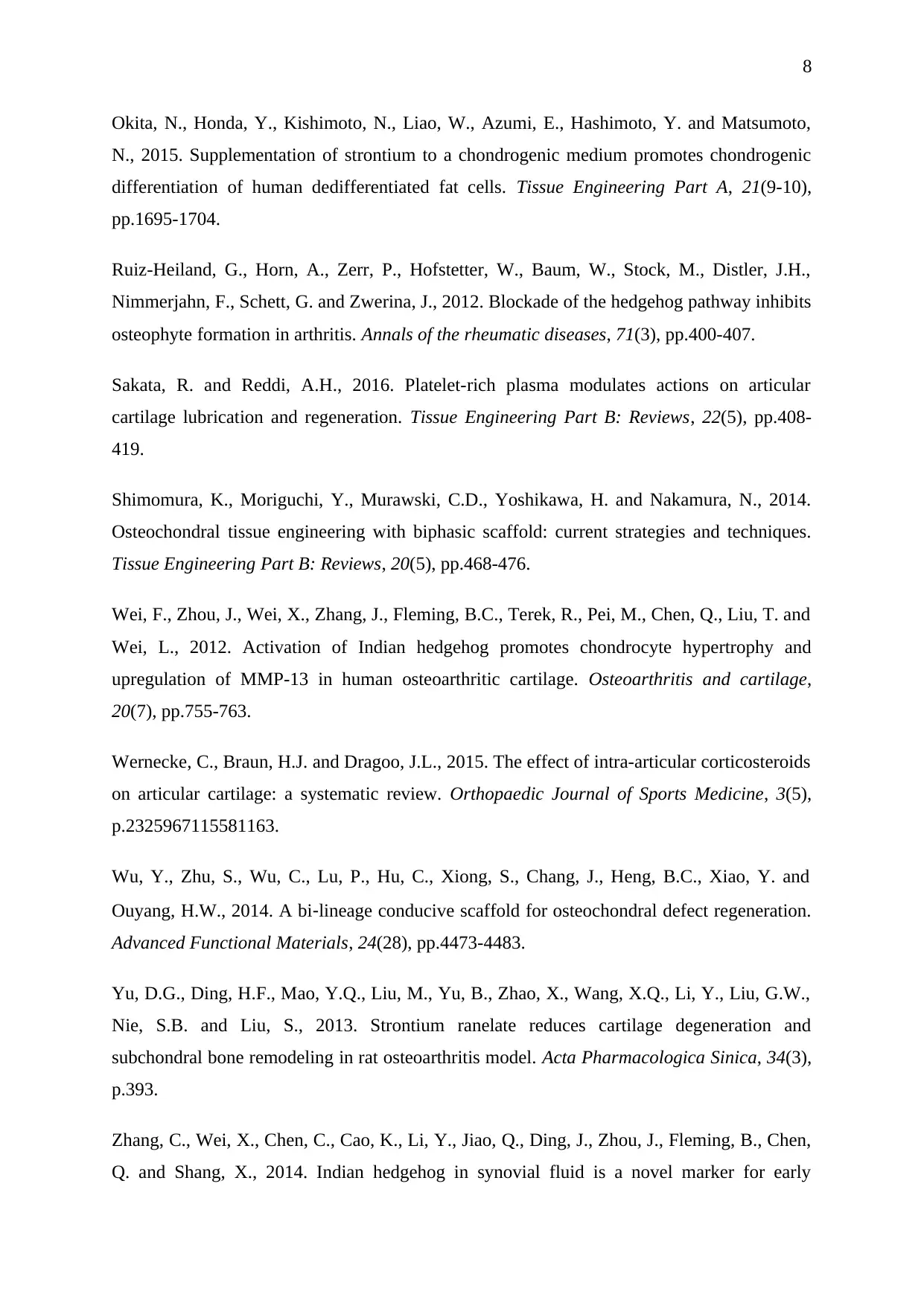
8
Okita, N., Honda, Y., Kishimoto, N., Liao, W., Azumi, E., Hashimoto, Y. and Matsumoto,
N., 2015. Supplementation of strontium to a chondrogenic medium promotes chondrogenic
differentiation of human dedifferentiated fat cells. Tissue Engineering Part A, 21(9-10),
pp.1695-1704.
Ruiz-Heiland, G., Horn, A., Zerr, P., Hofstetter, W., Baum, W., Stock, M., Distler, J.H.,
Nimmerjahn, F., Schett, G. and Zwerina, J., 2012. Blockade of the hedgehog pathway inhibits
osteophyte formation in arthritis. Annals of the rheumatic diseases, 71(3), pp.400-407.
Sakata, R. and Reddi, A.H., 2016. Platelet-rich plasma modulates actions on articular
cartilage lubrication and regeneration. Tissue Engineering Part B: Reviews, 22(5), pp.408-
419.
Shimomura, K., Moriguchi, Y., Murawski, C.D., Yoshikawa, H. and Nakamura, N., 2014.
Osteochondral tissue engineering with biphasic scaffold: current strategies and techniques.
Tissue Engineering Part B: Reviews, 20(5), pp.468-476.
Wei, F., Zhou, J., Wei, X., Zhang, J., Fleming, B.C., Terek, R., Pei, M., Chen, Q., Liu, T. and
Wei, L., 2012. Activation of Indian hedgehog promotes chondrocyte hypertrophy and
upregulation of MMP-13 in human osteoarthritic cartilage. Osteoarthritis and cartilage,
20(7), pp.755-763.
Wernecke, C., Braun, H.J. and Dragoo, J.L., 2015. The effect of intra-articular corticosteroids
on articular cartilage: a systematic review. Orthopaedic Journal of Sports Medicine, 3(5),
p.2325967115581163.
Wu, Y., Zhu, S., Wu, C., Lu, P., Hu, C., Xiong, S., Chang, J., Heng, B.C., Xiao, Y. and
Ouyang, H.W., 2014. A bi‐lineage conducive scaffold for osteochondral defect regeneration.
Advanced Functional Materials, 24(28), pp.4473-4483.
Yu, D.G., Ding, H.F., Mao, Y.Q., Liu, M., Yu, B., Zhao, X., Wang, X.Q., Li, Y., Liu, G.W.,
Nie, S.B. and Liu, S., 2013. Strontium ranelate reduces cartilage degeneration and
subchondral bone remodeling in rat osteoarthritis model. Acta Pharmacologica Sinica, 34(3),
p.393.
Zhang, C., Wei, X., Chen, C., Cao, K., Li, Y., Jiao, Q., Ding, J., Zhou, J., Fleming, B., Chen,
Q. and Shang, X., 2014. Indian hedgehog in synovial fluid is a novel marker for early
Okita, N., Honda, Y., Kishimoto, N., Liao, W., Azumi, E., Hashimoto, Y. and Matsumoto,
N., 2015. Supplementation of strontium to a chondrogenic medium promotes chondrogenic
differentiation of human dedifferentiated fat cells. Tissue Engineering Part A, 21(9-10),
pp.1695-1704.
Ruiz-Heiland, G., Horn, A., Zerr, P., Hofstetter, W., Baum, W., Stock, M., Distler, J.H.,
Nimmerjahn, F., Schett, G. and Zwerina, J., 2012. Blockade of the hedgehog pathway inhibits
osteophyte formation in arthritis. Annals of the rheumatic diseases, 71(3), pp.400-407.
Sakata, R. and Reddi, A.H., 2016. Platelet-rich plasma modulates actions on articular
cartilage lubrication and regeneration. Tissue Engineering Part B: Reviews, 22(5), pp.408-
419.
Shimomura, K., Moriguchi, Y., Murawski, C.D., Yoshikawa, H. and Nakamura, N., 2014.
Osteochondral tissue engineering with biphasic scaffold: current strategies and techniques.
Tissue Engineering Part B: Reviews, 20(5), pp.468-476.
Wei, F., Zhou, J., Wei, X., Zhang, J., Fleming, B.C., Terek, R., Pei, M., Chen, Q., Liu, T. and
Wei, L., 2012. Activation of Indian hedgehog promotes chondrocyte hypertrophy and
upregulation of MMP-13 in human osteoarthritic cartilage. Osteoarthritis and cartilage,
20(7), pp.755-763.
Wernecke, C., Braun, H.J. and Dragoo, J.L., 2015. The effect of intra-articular corticosteroids
on articular cartilage: a systematic review. Orthopaedic Journal of Sports Medicine, 3(5),
p.2325967115581163.
Wu, Y., Zhu, S., Wu, C., Lu, P., Hu, C., Xiong, S., Chang, J., Heng, B.C., Xiao, Y. and
Ouyang, H.W., 2014. A bi‐lineage conducive scaffold for osteochondral defect regeneration.
Advanced Functional Materials, 24(28), pp.4473-4483.
Yu, D.G., Ding, H.F., Mao, Y.Q., Liu, M., Yu, B., Zhao, X., Wang, X.Q., Li, Y., Liu, G.W.,
Nie, S.B. and Liu, S., 2013. Strontium ranelate reduces cartilage degeneration and
subchondral bone remodeling in rat osteoarthritis model. Acta Pharmacologica Sinica, 34(3),
p.393.
Zhang, C., Wei, X., Chen, C., Cao, K., Li, Y., Jiao, Q., Ding, J., Zhou, J., Fleming, B., Chen,
Q. and Shang, X., 2014. Indian hedgehog in synovial fluid is a novel marker for early

9
cartilage lesions in human knee joint. International journal of molecular sciences, 15(5),
pp.7250-7265.
cartilage lesions in human knee joint. International journal of molecular sciences, 15(5),
pp.7250-7265.
1 out of 9
Your All-in-One AI-Powered Toolkit for Academic Success.
+13062052269
info@desklib.com
Available 24*7 on WhatsApp / Email
![[object Object]](/_next/static/media/star-bottom.7253800d.svg)
Unlock your academic potential
© 2024 | Zucol Services PVT LTD | All rights reserved.
